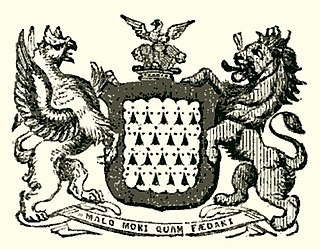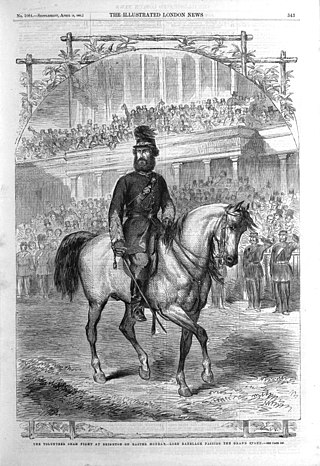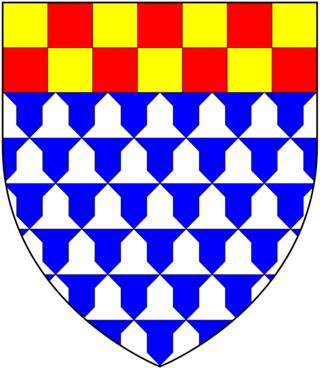Related Research Articles

Marquess of Headfort is a title in the Peerage of Ireland. It was created in 1800 for Thomas Taylour, 2nd Earl of Bective.

Earl of Kingston is a title in the Peerage of Ireland. It was created in 1768 for Edward King, 1st Viscount Kingston. The Earl holds the subsidiary titles Baron Kingston, of Rockingham in the County of Roscommon, Viscount Kingston, of Kingsborough in the County of Sligo, Baron Erris, of Boyle in the County of Roscommon, and Viscount Lorton, of Boyle in the County of Roscommon, also in the Peerage of Ireland. He is also a baronet in the Baronetage of Ireland. Between 1821 and 1869 the earls also held the title Baron Kingston, of Mitchelstown in the County of Cork, in the Peerage of the United Kingdom.

Earl of Normanton is a title in the Peerage of Ireland. It was created in 1806 for Charles Agar, 1st Viscount Somerton, Archbishop of Dublin. He had already been created Baron Somerton, of Somerton in the County of Kilkenny, in 1795 and Viscount Somerton, of Somerton in the County of Kilkenny, in 1800, also in the Peerage of Ireland. Lord Normanton sat in the House of Lords from 1800 to 1809 as one of the 28 original Irish Representative Peers.

Viscount Gormanston is a title in the Peerage of Ireland created in 1478 and held by the head of the Preston family, which hailed from Lancashire. It is the oldest vicomital title in the British Isles; the holder is Premier Viscount of Ireland.

Baron Trimlestown, of Trimlestown in County Meath, is a title in the Peerage of Ireland.

Viscount Ranelagh was a title in the Peerage of Ireland. It was created on 25 August 1628 for Sir Roger Jones, son of Thomas Jones, Archbishop of Dublin and Lord Chancellor of Ireland. He was made Baron Jones of Navan, in the County of Meath, at the same time also in the Peerage of Ireland. Thomas Jones's father was Henry Jones, of Middleton in Lancashire. The first Viscount was succeeded by his eldest son, Arthur, the second Viscount, who represented Weobly in the English Parliament. Arthur was succeeded by his son, Richard, the third Viscount, who was created Earl of Ranelagh in the Peerage of Ireland in 1677. On Richard's death in 1712 the earldom became extinct while the barony and viscountcy became dormant.

Viscount Frankfort de Montmorency, of Galmoye in the County of Kilkenny, was a title in the Peerage of Ireland. It was created on 22 January 1816 for Lodge de Montmorency, 1st Baron Frankfort, who had earlier represented Bandon Bridge, Dingle, Inistioge and Ennis in the Irish House of Commons. He had already been made Baron Frankfort, of Galmoye in the County of Kilkenny, on 31 July 1800, also in the Peerage of Ireland. Born Lodge Evans Morres, he assumed in 1815 by Royal licence the surname of de Montmorency in lieu of Morres. However, the French House of de Montmorency never recognised his claim to be a member of that house. His grandson, the third Viscount, was a Major-General in the British Army and sat in the House of Lords as an Irish Representative Peer between 1900 and 1902. The latter's eldest son, the Honourable Raymond de Montmorency, was awarded the Victoria Cross for his actions at the Battle of Omdurman in 1898. He was killed in action in the Second Boer War two years later, predeceasing his father by two years. The third Viscount was succeeded by his second and only surviving son, the fourth Viscount. He was also a soldier. He died childless in 1917 when the titles became extinct.
Christopher Plunket, 2nd Earl of Fingall and 11th Baron Killeen was an Irish politician and soldier. In 1641 he negotiated with the rebels on behalf of the Old English of the Pale and pushed them to join the rebellion. He fought for the rebels at the siege of Drogheda. He joined the Confederates and fought in their Leinster army, notably at Dungan's Hill. When the Confederates fused into the Royalist Alliance, he fought under James Butler, 1st Duke of Ormond in the Battle of Rathmines where he was wounded and taken prisoner. He died of his wounds two weeks later in captivity at Dublin Castle.

Baron Slane was a title in the Peerage of Ireland. It was created in 1370 for the Fleming family but forfeited in 1691.
Nicholas Barnewall, 3rd Viscount Barnewall (1668–1725) was an Irish nobleman who fought for the Jacobites but afterwards sat in William's Irish Parliament. He was buried in a beautiful monument at Lusk.
Nicholas Netterville of Dowth, County Meath, Ireland, was born in 1581, and succeeded his father, John Netterville, in the family estate on 20 September 1601. Although an enemy accused them of being "but a mean family" the Nettervilles had in fact been in Ireland since before 1280 and had been established at Dowth for centuries; they were related to many of the leading families of The Pale including the Earl of Kildare, Lord Slane, Lord Howth and the Luttrells of Luttrellstown Castle. Nicholas was the grandson of Luke Netterville, judge of the Court of King's Bench (Ireland) and nephew of the leading barrister and statesman Richard Netterville. His mother was Eleanor Gernon, daughter of Sir James Gernon of Castleton, County Louth. Being "a person of many good qualities" he was created, 3 April 1622, Viscount Netterville, of Dowth in the County Meath, taking his seat, 14 July 1634. He died in 1654 and was buried at Mountown, County Dublin.
Nicholas Barnewall, 1st Viscount Barnewall of Turvey, County Dublin, was an Irish landowner and politician.
Sir Patrick Barnewall or Barnwall, was the eldest son of Sir Christopher Barnewall of Turvey House, Grace Dieu Abbey, and Fieldston. Christopher in turn was the son of the elder Sir Patrick Barnewall, who in 1534 was made Serjeant-at-law (Ireland) and Solicitor-General for Ireland, and in 1550 became Master of the Rolls in Ireland. Patrick's mother was Marion Sherle, daughter of Richard Sherle of Shallon, County Meath: after his father's death, she remarried the prominent judge Sir Lucas Dillon. She died in 1607.
Sir Christopher Barnewall (1522–1575) was a leading Anglo-Irish statesman of the Pale in the 1560s and 1570s. He was the effective Leader of the Opposition in the Irish House of Commons in the Parliament of 1568–71. He is remembered for building Turvey House, where he sheltered the future Catholic martyr Edmund Campion, for his impressive tomb in Lusk Church, and for the eulogy to him in Holinshed's Chronicles, which was written by his son-in-law Richard Stanyhurst.
James Dillon, 1st Earl of Roscommon was an Irish peer.
Baron Galtrim was an Irish feudal barony: in other words, the holder of the barony, which was hereditary in the Hussey family, was entitled to style himself Lord Galtrim, but was not entitled as of right to sit in the Irish House of Lords, although at least two holders of the title did receive a summons to sit in Parliament, and a third sat in the House of Commons. The title was created in the late fourteenth century by summons to Parliament. Use of the title lapsed in the early nineteenth century: from then on the former Lord Galtrim was usually referred to simply as "Mr. Hussey of Rathkenny".
Robert Dillon, 2nd Earl of RoscommonPC (Ire) was styled Baron Dillon of Kilkenny-West from 1622 to 1641 and became earl of Roscommon only a year before his death. He supported Strafford, Lord Deputy of Ireland, who appointed him as one of the keepers of the King's seal. Lord Kilkenny-West was in December 1640 for a short while a lord justice of Ireland together with Sir William Parsons.
Turvey House was a substantially altered 16th century house synonymous with the townland of Turvey near Donabate in North County Dublin. Turvey is said to be a reference to the Irish mythical character Tuirbe Tragmar, father of Gobán Saor.
Luke Plunket, 3rd Earl of Fingall (1639–1684) was an Irish soldier and politician. He was one of the signatories of the Catholic Remonstrance of 1661.

Nicholas Preston, 6th Viscount Gormanston (1606–1643) sat in the House of Lords of the Irish Parliament of 1634–1635 and sided with the insurgents after the Irish Rebellion of 1641.